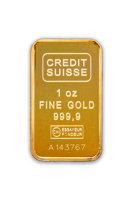Posted on June 20, 2021


Swiss gold is famous worldwide. This relatively small nation (the size of Vermont and New Hampshire combined), which has the population of New York City, has been a leading refiner of gold and other precious metals for over three centuries.
Swiss banks store the gold bars minted in renowned Swiss refineries like PAMP, Valcambi, and Metalor. In fact, an estimated 70% of the world’s gold makes its way through Switzerland to be refined. This is both curious and amazing -- because, despite all those mints and refineries, Switzerland has no gold deposits of its own.
So how did a country with no naturally occurring gold become such a significant player in the gold markets?
In 2011, Switzerland imported over 2,600 metric tons of raw gold valued at over $100 billion at the time, and nearly equivalent to the total supply of gold mined that year worldwide (2,700 tons). The following three years saw import figures of 1,800 tons, 2,600 tons, and 1,750 tons, respectively, and these figures do not include gold held or traded by the Swiss central bank.
With the majority of the world’s gold passing through Switzerland, there’s a good chance that any gold you own at home was minted or refined by one of the following major Swiss refineries:
The refineries are famously secretive about their exact production figures. PAMP head of bullion production Alberto Candiani gave the BBC a tour of the refinery in 2012 but was unable to disclose the number of bars produced each day.
However, it is known that PAMP has an annual refining capacity of 550 tons of gold. The Argor-Heraeus smelting plant reportedly produces 400 tons of gold each year. Valcambi has an annual refining capacity of 1,500 tons per year, the largest gold refining capacity in the world. It produces 6.6 tons of bars and coins daily. Finally, Metalor has an annual refining capacity of approximately 650 metric tons.
In other words, Switzerland’s big four refineries can pretty much handle the entire world’s annual gold production. Every year.
 Bullion is called “Swiss gold” if it was produced by one of the refiners listed above. Swiss gold has a worldwide reputation for quality. Swiss gold is known to possess the “four nines,” a reference to the 99.99% purity typically found in Swiss gold bars and other gold products.
Bullion is called “Swiss gold” if it was produced by one of the refiners listed above. Swiss gold has a worldwide reputation for quality. Swiss gold is known to possess the “four nines,” a reference to the 99.99% purity typically found in Swiss gold bars and other gold products.
Swiss refineries are on the Good Delivery list of a certain London-based trade group which will remain nameless, an internationally recognized seal of approval in the gold markets. In fact, out of the five Referees responsible for maintaining the Good Delivery List for the entire industry, three of them are Swiss refineries (Valcambi being the exception).
Swiss gold is typically eligible for purchase within a precious metals IRA, and again, this is due to the recognition that the gold is of exceptional quality.
While there are many articles and sources of information discussing Switzerland’s role and history in the gold markets, few, if any, tell the full story.
Some point out that Switzerland is a military stronghold and this is the reason for its gold hub status (that and its failure to join any war since 1847). When all of Europe is at war with itself as it seems to be every four or five decades, a neutral nation known for its banks makes a great place to store wealth. Other observers note that Swiss banks owned so much gold during World War II that it simply made sense to set up refineries in the country.
 But how did it all start? Where did the gold come from? It all started with the Swiss banks...
But how did it all start? Where did the gold come from? It all started with the Swiss banks...
The Swiss banking system has long been shrouded in secrecy, dating back as far as the 1700s.
The Great Council of Geneva ruled in 1713 that disclosure of private information about the Swiss ruling class was illegal, and Catholic French Kings began to deposit their holdings in Switzerland to avoid a Protestant-run banking system. Not even kings want to be audited.
The Congress of Vienna established Switzerland’s international neutrality in the 1800s, and Swiss bankers traveled abroad to spread the word about the nation’s banking secrecy at the start of the 20th century. When World War I broke out, there was a major influx of capital to Switzerland, a neutral state nestled in a defensive position high up in the mountains.
The Swiss Banking Act of 1934 made it illegal for banks to disclose client information to any third party without that client’s consent, allowing foreign clients to store capital in Switzerland without their own government being able to access or seize it. That’s where the stories of mysterious, ultra-secret “Swiss bank accounts” come from.
When WWII broke out, another influx of capital was seen, mainly from German forces looting conquered territory. Billions of dollars of gold were looted by German forces during WWII and redirected to the Swiss National Bank for storage, despite the Swiss government’s supposed neutrality in the war.
A key aspect of Switzerland’s rise to become the leading hub for refining gold is the formation of the Zurich Gold Pool.
In March 1968, the London Gold Pool collapsed due to a shortage of Good Delivery gold, causing serious short-term volatility in gold prices and a threat to the reliability of pricing in general. (Remember, at the time, the U.S. dollar and many other currencies were tied to gold.) The Union Bank of Switzerland (UBS), Swiss Bank Corporation (SBC), and Credit Suisse banded together to handle the pricing of gold, and South African gold producers abandoned London in favor of Switzerland as a result.
Switzerland essentially took over the global bullion trade, aided by attractive privacy laws promising discretion and anonymity for a growing list of international clients. By the 1970s, Switzerland was already handling 70% of the world’s physical gold trade.
The Bank for International Settlements (BIS) is headquartered in Switzerland and acts as the central bank of central banks globally, brokering gold trades between national central banks. The Swiss National Bank (SNB) manages the 8th largest reserve of central bank-owned gold globally, holding over 1,040 tons at last count.
Switzerland is a titan of the banking industry, and the extensive financial infrastructure is a major factor in the small nation’s role as a gold hub. Consider: Switzerland is 101st of the world’s 235 nations in terms of population. In terms of GDP, Switzerland comes in 20th. UBS and Credit Suisse are the 33rd and 41st largest banks in the world. Despite its compact size, this mountain nation is a heavy hitter in global economics.
What’s more, gold is classed as currency in Switzerland, making it exempt from VAT and customs duties.
This last point is crucial, making the process of moving physical gold in and out of the country seamless and cost-effective as well as, of course, utterly private.

After centuries of building a highly secretive banking system designed to protect vast sums of capital in a politically neutral nation, Switzerland seized a unique opportunity at the collapse of the London Gold Pool.
Major gold producers, such as in South Africa, Canada, and the U.S., saw that Switzerland was a viable alternative to London -- a country both physically and politically insulated from war and civil unrest, one with exceptionally strong privacy laws and no customs or value-added tax on the buying and selling of gold.
Switzerland already had a robust financial services sector with a centuries-long tradition of discretion and privacy. In addition, the nation sat out the 20th century’s largest and most destructive wars. Switzerland is almost shockingly politically stable -- a brief civil war in 1847 codified the republic of relatively autonomous cantons (some of which have a history of democracy going back 700 years).
All these factors, combined with an established network of gold refineries active in the country, led to the perfect conditions for Switzerland to become the international hub of gold refining that we see today.